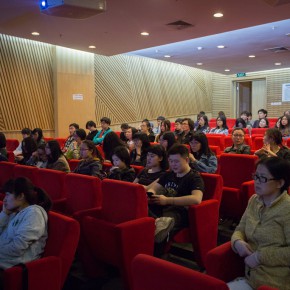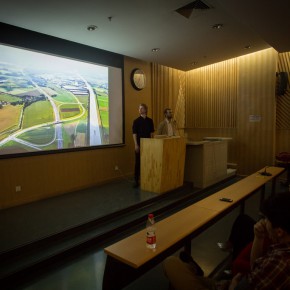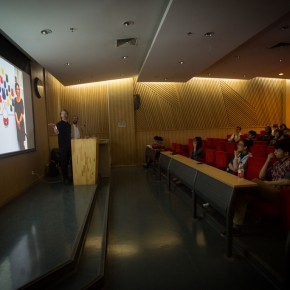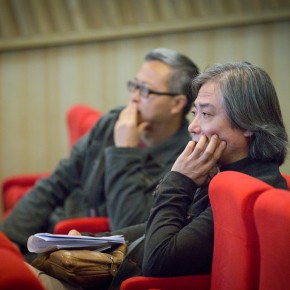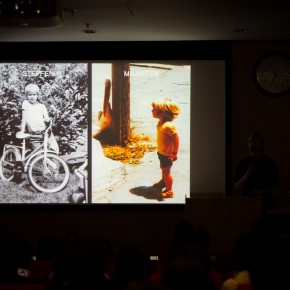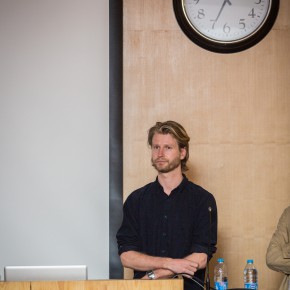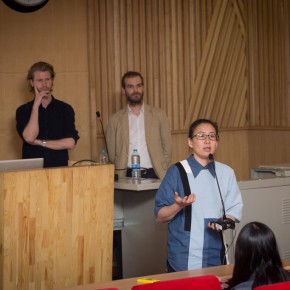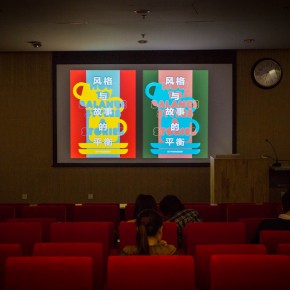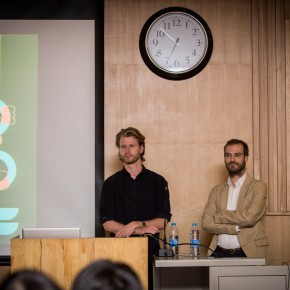
On March 31, 2014, Dutch designers Steffen & Maarten gave a lecture entitled “How to Balance Styles & Stories” at the Red Chair Lecture Hall of building 7, CAFA, speakers Steffen and Maarten are from Facing Spaces in the Netherlands, they organized design workshops in the design school, and also presided over teaching work in many colleges and universities in the Netherlands.
Steffen and Maarten talked about their impressions of China, and the different cultures of the two countries through their eyes. Through 300 photos they shared the origin of ideas and thoughts on the programs, which brought a lot of inspiration to the students of the School of Design.
Steffen and Maarten initially said, they were independent designers, so they could freely arrange their time, they had learned a lot of Chinese elements through the communication with China. The most important thing for the designers was the narrative of visual language and the application of the visual narrative in graphic design. They then showed the photos of their childhood, and said they liked to use the perspective of children to see the world, because there was not any critical standard, it was very free. They said that curiosity from the heart was the key to becoming a designer. They stressed that although the designer was very busy they had to spend time on reflection and recall what they had done, and never stop to imagine.
The two countries had communicated frequently over the years, and learning from each other through cultural exchanges, Steffen and Maarten thought, the Netherlands borrowed the porcelain technology from China, while the buildings in Shanghai also learnt from the Dutch buildings of the 17th Century, and Van Gogh and Miffy from the Netherlands also greatly influenced China. In their view, Chinese people were very good at using public spaces, and they were surprised by Chinese people involved in fitness, playing chess, trading in the open air, as Dutchmen are too shy to do this in the open air and always performed indoors.
Steffen and Maarten thought that it was necessary for a designer to collect a large number of elements to concentrate into a symbol. For example, “The Bible” was expressive but only the rich could afford it and understood the text, so it was not exposed to most of the poor, then it generate visual communication. Painting in the church told the stories of “The Bible”, and then it became more and more symbolic. “Chinese Redbud Crown” had become the most concise language to express the stories of “The Bible”.
Subsequently, Steffen and Maarten displayed the categories of their projects using pictures, including a variety of brand promotions and poster designs, which were not limited to the traditional project. They thought that the designers would think about how to make their designs in a large space. They showcased the design works without a fixed style, and they thought that it was proper that the design idea was derived according to the customers’ requirements and the contents.
Steffen and Maarten’s project involves a wide range: design of the font, design for the public, album design for visual artists, design of exhibition space, mobile phone ads and flyers for a variety of companies, etc. Among this they focused on a project for the branding and logo design of a Dutch high-grade food company. They were dedicated and visited the factory, shot the whole process of the production of the food, and interviewed customers about their perceptions of the food. Creating a platform on the internet at the same time as screening a VCR on the production of the food, so that the customers could share their feelings and enhance their understanding of the food. Posters of the food finally used black because Dutch people like black, which was also a symbol of nobility.
Another example was design for the monument of Dutch democracy fighters in World War II. They had learnt that China generally applied stones or marbles to highly enshrine and worship objects, while they hoped to close the distance between the audience and the historical figures, so they used common household materials, and engraved the democratic fighters’ information on park chairs, or on places that are easy for the local people to reach.
As teachers, they tend to lead the students to go out looking for elements that they are interested in, and then help the students to simplify elements, abstracting the most important symbols. Steffen and Maarten believed that a good designer should let the customer see another possibility, rather than just complete a task or focus on form. Designers should often exchange and communicate with customers and other designers, to promote the construction of the cultural field, which would increase the angles for the viewers, enriching the way of thinking. They finally stressed that the designer’s curiosity was very important, because the ambition to explore would keep people interested in it, while thinking in the same way as a designer, one could design a good work, and they hoped to change people’s idea of design through design work.
Journalist: Ye Yuanfeng, translated by Chen Peihua and edited by Sue, Photo: Hu Zhiheng/ CAFA ART INFO



